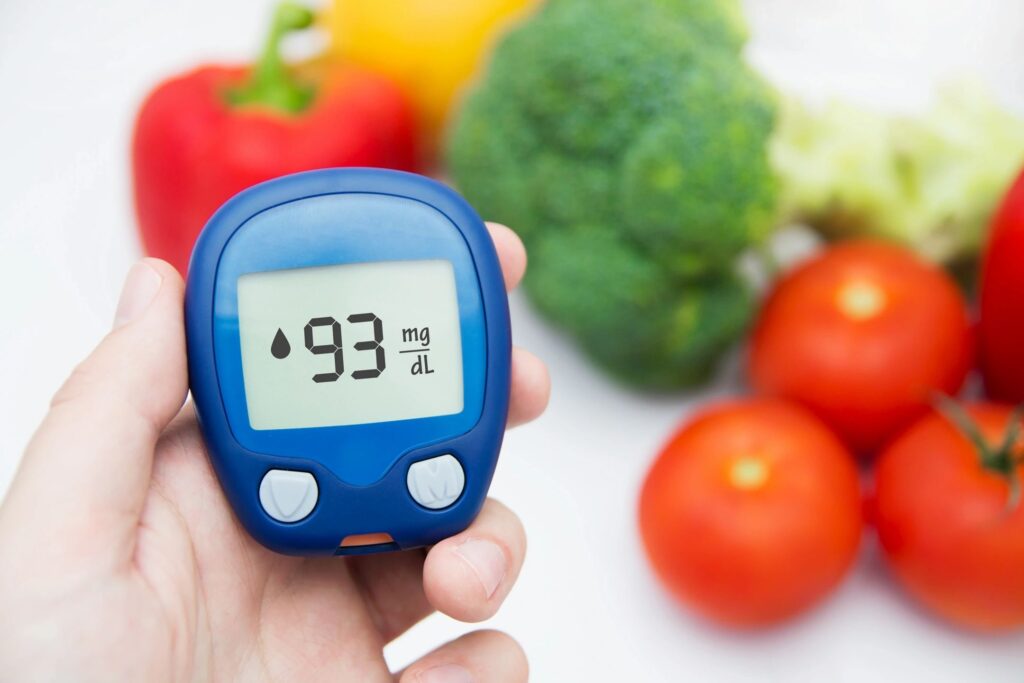What to Eat with Diabetes: A Complete Guide
Table of Contents
- What to Eat with Diabetes: A Complete Guide
- A story
- What is Diabetes?
- Types of Diabetes
- How different Types of Diet Affect Diabetes
- Specific Dietary Needs of People with Diabetes
- How to Create a Meal Plan for People with Diabetes
- Diabetic Meal Prep 101
- Tips for Eating Out with Diabetes
- Managing Diabetes during the Holidays & Special Occasions
- Tips for Managing Diabetes During the Holidays & Special Occasions
- Common Myths about Diabetes and Diet
- Your Diabetic Care Team & Managing Diabetes
- Conclusion
A story
I was sitting by my desk when I got a call from a 48-year-old man a day after he returned from Florida. He was panicking that he had a splinter from walking on the boardwalk barefoot, and now it “won’t heal.”

How did a great vacation with his family to the boardwalk turn into panic? It happens every day. You never knew you had diabetes until recently. Maybe this is similar to your story or someone you know.
You probably have a lot of question like this patient did. Questions like how to manage diabetes, what to eat, what to look out for and what doctors to see.
I get these questions all the time when I talk to patients. Diabetes can be a major life-changer, but it doesn’t have to be overwhelming.
The first thing to do is to make an appointment with your primary care physician. I’ll also discuss what other doctors you should get in contact with to manage your diabetic care.
But first let’s do some housekeeping…
What is Diabetes?
Diabetes is a chronic condition that affects how your body turns food into energy. When an individual has diabetes, their body either doesn’t make enough insulin or doesn’t use insulin properly.
Insulin is a hormone that helps the cells use glucose for energy. It is a type of sugar that the body gets from the food we eat.
If the blood sugar is too high, it can damage nerves and blood vessels. This can lead to serious health problems, such as heart disease, stroke, blindness, and kidney failure. Blood sugar monitoring is vital to managing diabetes.
The American Diabetes Association gives updated evidence-based recommendations for preventing complications for people living with diabetes.
Types of Diabetes
There are three main types of diabetes- Type I, Type II and Gestational Diabetes:
- Type 1 diabetes is an autoimmune disease that causes the body to attack and destroy the cells of the pancreas. The pancreas is responsible for making insulin. People with type 1 diabetes must check their blood sugars frequently and take insulin every day to manage their blood sugar levels. In addition, your doctor may prescribe
 oral medications along with dieting recommendation to keep your blood sugars under control.
oral medications along with dieting recommendation to keep your blood sugars under control.
- Type 2 diabetes is the most common type of diabetes. It develops when the body becomes resistant to insulin or doesn’t make enough insulin. People with type 2 diabetes can manage their blood sugar levels through diet, exercise, and weight loss. However, some people with type 2 diabetes may also need to take oral medications and insulin. Common medications are Glucophage, Glipizide, Novolog Insulin pen, and many more.
- Gestational diabetes develops during pregnancy. It usually goes away after the baby is born. However, it increases the risk that a woman will develop type 2 diabetes later in life
How different Types of Diet Affect Diabetes
All types of diabetes require careful management of blood sugar levels. However, the specific dietary recommendations for people with diabetes vary depending on the type of diabetes and the individual’s needs.
Type 1 diabetes: People with type 1 diabetes may need to carefully count carbohydrates (carbs) and match their insulin intake to the amounts of carbs they consume. There are many carb trackers that makes it easier for you to manage your carb intake. Carb tracking is important because they have the biggest impact on blood sugar levels.

People with type 1 diabetes also need to ensure eating regular meals and snacks throughout the day to avoid low blood sugar levels. For example, if Mary eats a high carb meal like frosted flakes with milk, she should expect to administer more insulin to keep her insulin in the normal range. Likewise, if she had a low carb meal like sausage and peppers, she should plan to snack throughout the day to keep her blood sugars in a safe range.
Type 2 Diabetes: People with Type 2 Diabetes often need to make changes to their diet to lose weight and improve their blood sugar control. This may involve eating fewer calories, choosing healthier foods, limiting processed foods, sugary beverages and unhealthy fats. People with Type 2 diabetes may also need to count carbohydrates and match their food intake to their insulin (if they take insulin).
Gestational Diabetes: It is advised that women with gestational diabetes follow a healthy diet. They should follow diets that include lean protein, fruits, vegetables and limit processed or fried foods. Caloric requirements of the mother depend on the trimester of pregnancy, current weight of fetus and other factors. Women experiencing gestational diabetes must work closely with their doctor and a registered dietician. This will help to customize a health plan that will promote a healthy pregnancy.
Specific Dietary Needs of People with Diabetes
People with diabetes need to eat a variety of healthy foods to maintain a healthy weight and meet their daily caloric needs.
Here are some essential nutrients for people with diabetes:

- Carbohydrates are the body’s main source of energy. However, people with diabetes must be careful regarding how many carbohydrates they eat. Carbs can raise blood sugar levels quickly. A “carb overload” can cause serious medical issues. Good sources of carbohydrates for people with diabetes include fruits, vegetables, and whole grains.
- Protein helps the body to build and repair tissues. It can also help to slow down the digestion of carbohydrates. This can help to keep blood sugar levels stable instead of spiking. Good sources of protein for people with diabetes are lean meat, chicken, fish, beans, lentils, and nuts.
- Fat is an important source of energy, but diabetics must be careful to choose healthy fats. Healthy fats include monounsaturated and polyunsaturated fats that are found in olive oil, avocados, nuts, and seeds. People with diabetes should avoid saturated and trans fats, which are found in fatty meats, full-fat dairy products, fried and processed foods.
- Fiber helps us to feel full after a meal. It helps to regulate blood sugar levels. Good sources of fiber include fruits, vegetables, and whole grains.
- Vitamins and minerals are essential for good health. People with diabetes need to ensure that they are getting enough vitamins and minerals. They should also ensure that they are high quality. Choosing the best vitamin supplement to take is relatively easy using this guide. Good sources of vitamins and minerals include fruits, vegetables, and whole grains.
How to Create a Meal Plan for People with Diabetes
Every once in a while, I talk to a patient who hates the idea of meal planning. I often hear their frustration of being bored by food choices or being overwhelmed during the holidays or eating out.
Let’s be honest, carb counting is a lot of work and food prep can be time consuming.
However, it doesn’t have to be overwhelming. There are many free and affordable meal planning apps, carb counters and resources available to help you. Our overall top pick would be a personalized diet program that is comprehensive and easy to follow.
Diabetic Meal Prep 101
The first step in creating a meal plan is to see what you already have and what you need.
- Write down the foods you like or any recipe that you would like to try. Also, keep in mind the time commitment when making these meals, after all, you want food prepping to be fun. Healthy eating is a lifestyle.
- Create a grocery lists for the recipes you want to try. Additionally, you can use left overs to create something you’ve never tried before.
- Try to limit your cooking time to 30 minutes. You want to feel excited about preparing meals, so that you can prepare healthy meals on a long term basis.
- Make your meal prepping easier with the tools you have. Whether you prefer to use meal planning apps, kitchen gadgets, whatever it is, get the help that you need to start your healthy eating journey.
Below is a list of diabetic-friendly foods:
| Types of Foods | Examples |
|---|---|
| Fruits, Vegetables, Whole grains | non-starchy veggies like broccoli, tomatoes, peppers Whole grains like brown rice, seeded breads, quinoa. |
| Lean Protein | chicken (no skin) fish, beans, tofu |
| Good Fats | low fat dairy healthy oils (olive oil, canola oil) lean protein |
| Healthy Snacks | nuts, raw vegetables (or slightly steamed), apple sauce (no added sugar) |
Tips for Eating Out with Diabetes
When it comes down to eating out it can be tricky. Many newly diagnosed diabetics get overwhelmed with the thought of eating out and that’s understandable. But before you panic, I want to share a couple of tips so that you can be in control.
The type of restaurant makes the difference- at fast food restaurants it’s difficult to find a healthy substitute. Here are a few tips that can help you make healthier choices when eating out:
- Choose a restaurant that has healthy options. Many restaurants now offer healthy meals, such as grilled fish and chicken, salads, and vegetables. You can also look for restaurants that have that have healthy menu section.
- Plan your meal ahead of time. If you know the name of the restaurant or the types of food offered at the restaurant, plan ahead of time. Reseach their menu online and decide what to order before you go. This will help you to avoid making unhealthy choices when you are hungry.
- Be mindful of your portion sizes. Restaurant portions are often much larger than what you would eat at home. Try to fill up on foods that are of low calories such as salads and veggies to limit consuming large portion sizes.
- Have a carb counter handy. Carefully document or estimate the amount of carbs you have eaten. This will be important when it comes to adjusting your insulin.
- Ask for substitutions. If you see a dish that you like, but it is not healthy, you can ask to substitute a healthy ingredient. For example, you can ask for grilled chicken instead of fried chicken, or for steamed vegetables instead of mashed potatoes.
- Scan the menu for healthy desserts. Desserts usually get a bad rap because of the carbohydrate content. Choosing a low-carb dessert will keep you from having a spike in blood sugars- and that’s great! Yogurt and fruit can be healthy substitutes for dessert. Instead of having a large slice of cake, insist on eating smaller. Sugar doesn’t have to be off limits, but moderation is the key when choosing the right dessert while dining out.
Managing Diabetes during the Holidays & Special Occasions
The holidays and special occasions can be a challenging time for people living with diabetes. There is often a lot of food around, wine, sodas and desserts. Yes, it is a struggle.
It’s difficult to resist temptation of the cookies and cakes, especially when you are hungry. What I don’t want is for you is to be eating broccoli in a corner by yourself. If the holiday season was the first time living with diabetes- you are not alone. It is estimated that over 38 million people in the US alone are living with diabetes.

The holidays and special occasions are about creating memories with your loved ones, and the food happens to be a bonus. The trick is to eat high nutrients food that fills you up and allows you to maintain a good A1C, which is the average blood sugar levels over 2-3 months.
Tips for Managing Diabetes During the Holidays & Special Occasions
Here are some tips that can help you this during special seasons:
- Manage your stress. Planning for a large family gathering or traveling for the holidays can be stressful. Stress can also raise blood sugar levels. It is important to manage your stress during the holidays by relaxing as much as possible. Some simple ways to relax are walking, reading and exercise. Be sure to talk to your doctor before starting an exercise program.
- Don’t be afraid to say no to certain foods. If you are offered something that you don’t want to eat or is unhealthy, graciously decline. Don’t be afraid to say no to foods that will cause your blood sugar to spike. You are taking responsibility in managing your health. Be proud of that.
- Monitor your blood sugar levels. It is important to monitor your blood sugar levels more closely during the holidays and special occasions. Diet changes and stress of upcoming events and holidays may cause your numbers to spike. Carefully monitoring your blood sugars will help you to make sure that your numbers are under control. Speak with your doctor immediately if your insulin needs adjusting.
- Get creative with your meals. There are many healthy and delicious recipes available online and in cookbooks. Get creative with your meals and try some new recipes.
Managing diabetes during the holidays and special occasions can be challenging, but it is possible. Don’t let diabetes stop you from enjoying yourself. Proper management of diabetes is the key to preventing complications of diabetes.
Common Myths about Diabetes and Diet
Now that you know more about diabetes, I hope that you feel more confident about managing your health. With any new diagnosis, it’s hard to decipher the truth sometimes. Let’s talk about some of the myths that you have probably heard. It’s time to set the record straight about diabetic care.
7 Common Myths About Diabetes
True or False: People with diabetes can’t eat sugar.
False: People with diabetes can eat foods containing sugar. However, as mentioned they need to be mindful of their portion sizes and how often they eat sugary foods. Eating foods with high sugar content like cookies and candies can raise your blood sugar levels and increase the risk of complications from diabetes.
True or False: People with diabetes need to eat a special diet.
True: It is recommended that people diagnosed with diabetes should follow a diet that is healthy and low carb. They can eat the same healthy foods as everyone else but need to be mindful of their carbohydrate intake. Carbohydrates break down into sugar when digested which can cause blood sugar levels to spike. Some carbohydrates like white bread and sugar cookies cause rapid spikes in blood glucose. If they take insulin, they must also plan to have snacks throughout the day to maintain healthy blood sugar levels.
True or False: People with diabetes can’t eat bread, pasta, or rice.
False: People with diabetes can eat bread, pasta, and rice. However, they need to choose whole-grain varieties like multigrain or seeded breads, brown rice or whole wheat pasta. Whole grains are high in fiber, that helps to slow down the digestion of carbohydrates and prevents spike in blood sugars.
True or False: People with diabetes can’t eat fruit.
False: People with diabetes can eat fruit. Fruit is an excellent source of vitamins, minerals, and fiber. However, fruits have a high sugar and carb content seen in mangoes and bananas. Fruits with low-sugar content are strawberries, raspberries etc.
True or False: People with diabetes can’t eat chocolate.
False: People with diabetes can eat chocolate, but they should choose dark chocolate over milk chocolate or white chocolate. Dark chocolate is lower in sugar content and higher in antioxidants than other types of chocolates.
Your Diabetic Care Team & Managing Diabetes
You may still have many more questions about managing your diabetes. Your doctor as well as other members of the healthcare team will be your resource. I encourage you to speak with them so that you can get the resources you need. Your care team may include a:
- Primary care physician (PCP): A PCP is a doctor who provides general medical care. They can help you to manage your diabetes and other medical conditions. They may also prescribe medications and other programs.
- Endocrinologist: An endocrinologist specializes in the endocrine system. The endocrine system includes the glands that produce hormones. Endocrinologists often treat people with diabetes, especially those with complex cases.
- Diabetes Educator: A diabetes educator is a healthcare professional who can teach you about diabetes and how to manage it. They can also help you to create a meal plan and exercise routine that suits your lifestyle.
- Registered dietitian (RD): An RD is a healthcare professional who can help you to create a healthy meal plan that meets your nutritional needs.
- Eye doctor: People with diabetes are at increased risk of developing eye problems, such as diabetic retinopathy (damage to the blood vessels in the eye). It is important to see an eye doctor for yearly checkups.
- Foot doctor: People with diabetes are also at increased risk of developing foot problems like neuropathy or ulcers. A small nick from filing your toenails or wearing uncomfortable shoes can lead to blisters and ulcers. It is important to see a foot doctor for regular checkups to detect any problems early.
Conclusion
Diabetes is a condition that affects millions of people around the world. Living healthy with diabetes is possible with the tools and medications we have today.
Eating a healthy diet is one of the most important things that people living with diabetes can do to manage their blood sugar levels. A diet that promotes stable and normal blood sugars helps to reduce the risks of complications from diabetes.
The best diet for people with diabetes is a well-balanced diet that includes vegetables, fruits, lean protein, rich in fiber and low fat.
It is important to note that there is no “one size fits all” plan. This means, these recommendations are a guide and people living with diabetes should speak with their doctor or other healthcare professional for a plan that’s best for them.
Medical Disclaimer: The content of the post is intended for informational and educational purposes only. It is not intended to diagnose or treat. Individuals should consult with a licensed health professional regarding their health concerns.
Source
American Diabetes Association
Know your facts about diabetes | ADA. (n.d.). https://diabetes.org/about-diabetes/diabetes-myths



